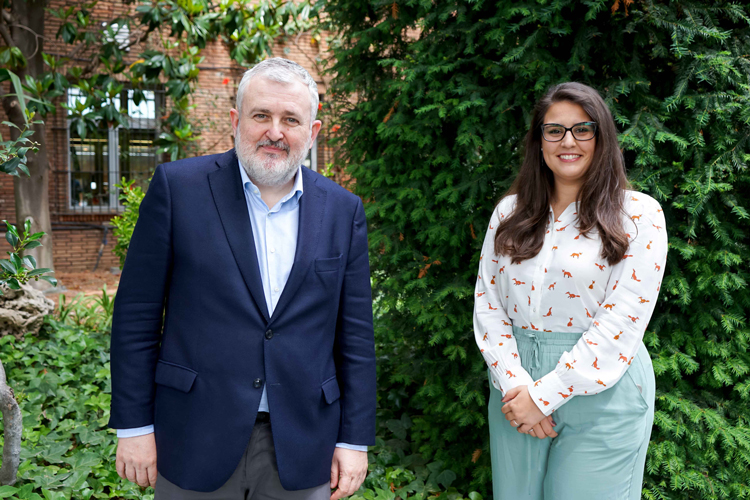Dr Cristina García has recently defended her doctoral thesis at IQS, in which she has developed a urinary catheter equipped with a micro-and nano-structured coating with bacteriophobic characteristics, offering a clear alternative to commercial catheters.

Dr Salvador Borrós and Dr Cristina Garcia
Around 80% of infections detected in the urinary tract are related to the use of a urinary catheter. These infections can become persistent or chronic over prolonged periods of use. There are two types of treatments for these infections: either with antibiotics, which present the problem of bacteria that are resistant to them, or by flushing the catheters with a saline solution. However, the problem of bacteria colonization persists as bacteria are capable of adhering to the surface of the catheter and remaining there, becoming a bacterial reservoir.
There are examples of super-hydrophobic surfaces in nature, both in plants and animals, with nanostructured topographies that manage to prevent bacteria from adhering to them. Silver, for example, is an element that makes it possible to obtain different surfaces with such properties. Thus, in a bio-inspired approach, the solution appears to be using a micro, nanostructured surface with silver coatings.
Within this context, Dr Cristina García Bonillo defended her doctoral thesis at IQS, entitled Nanostructured silver-based bacteriophobic surfaces against catheter-associated urinary tract infections. Her thesis was conducted within the Materials Engineering Group (GEMAT) at the IQS School of Engineering under the supervision of Dr Salvador Borrós, and featured collaboration from the company Tractivus, an IQS spinoff. Dr García Bonillo's thesis also fell under the Government of Catalonia's Industrial Doctorates Plan, supported by co-financing between the company Laboratorios Rubió and the IQS School of Engineering (Ramon Llull University).
Bacteriophobic urinary catheter
Dr García Bonillo's thesis developed a Foley-type urinary catheter with bacteriophobic characteristics. The catheter is based on a super-hydrophobic micro, nanostructured coating with a specific topography, covered by a homogeneous metallic silver film. This film creates an uncomfortable environment for bacteria, preventing their adherence to the surface, yet does not impact bacterial growth that benefits patients by protecting their own microbiota.
To achieve this, a series of super-hydrophobic nanostructured coatings were created based on different polymers relying on plasma polymerized pentafluorophenyl methacrylate (pp-PFM) and polydopamine (PDA), coated with a thin film of metallic silver. These structures are capable of adapting to the morphology of the urinary catheter and its movement without delaminating or breaking. All of the structures showed a reduction in bacterial adhesion between four and six orders of magnitude with respect to uncoated polydimethylsiloxane (PDMS), as well as the ability to repel protein adhesion in in vitro assays.
The coating based on PDA-silver was selected to be implemented in the urinary catheter prototype. This coating was able to maintain the bacteriophobic effect for thirty days in tests carried out in vitro, with simulated use trials under flow and static conditions using uropathogenic bacterial strains and clinical isolates.
Finally, the catheter was validated in vivo using the animal model of catheterized pigs for fifteen days. During this period, the catheter was able to maintain bacterial adhesion two orders of magnitude lower than standard commercial catheters and commercial catheters with antimicrobial properties, thus providing a clear alternative to current catheters.
Industrial Doctorates Plan
The objective of the Industrial Doctorates Plan is to contribute to the competitiveness and internationalization of Catalan industry, strengthen the tools for attracting the talent developed in Catalonia, and put future doctors in a position to be able to conduct R&D&i projects within companies.
The essential element of the Industrial Doctorates Plan process is a company or institution's research project in which a doctoral student carries out research work, in collaboration with a university or research centre, which is the subject of a doctoral thesis. In this way, industrial doctorates act as a bridge to transfer knowledge and contribute to strengthening relationships between industry, higher education, and research centres.











